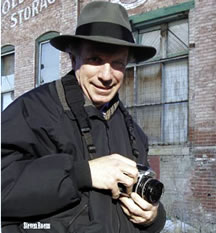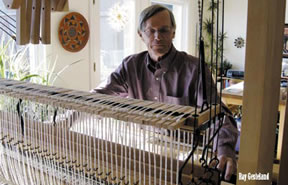
Vol. 15 No. 4 |
Spring 2006 |

For
dedicated researchers at the University of Utah, the process of discovery
never ends. This is also true for many U professors who, away from the
classroom and in their nonprofessional lives, pursue artistic endeavors.
 Each
month, during University Academic Senate meetings, Leslie Pickering
Francis, professor and chair of the Department of Philosophy,
can be seen knitting, her needles and fingers flying as she throws the
yarn, all the while intently watching and listening to the speakers. “I
knit in all of my meetings,” says Francis, also Alfred C. Emery
Professor of Law, who is quick to explain that she does not mean any disrespect
to those speaking. On the contrary, she says, she is actually more attentive
when knitting. “Some people doodle; I knit while I’m thinking
and reading.”
Each
month, during University Academic Senate meetings, Leslie Pickering
Francis, professor and chair of the Department of Philosophy,
can be seen knitting, her needles and fingers flying as she throws the
yarn, all the while intently watching and listening to the speakers. “I
knit in all of my meetings,” says Francis, also Alfred C. Emery
Professor of Law, who is quick to explain that she does not mean any disrespect
to those speaking. On the contrary, she says, she is actually more attentive
when knitting. “Some people doodle; I knit while I’m thinking
and reading.”
In 2000, Francis was presented with the U’s most prestigious award, the Rosenblatt Prize for Excellence, for her interdisciplinary research and teaching on issues of social justice, philosophy of law, and applied ethics. She also takes a philosophical approach to her handwork, which includes sewing and quilting, and views the traditional crafts as “community enterprises” reflective of women’s lives, suffusing her work with personal significance. For example, she has gathered yarn from places such as Scotland, which she visited after she and her husband, John, were married and living in Oxford.
One especially important project—her daughter’s wedding quilt—incorporated fabrics with historical and geographical significance from both sides of the family. Included were muslin from the “trial run” wedding dress; material from Southern Illinois, where Francis’s father grew up; fabrics from Francis’s, her mother’s, and her paternal grandmother’s collections; material from Cape Cod, where her father owned a home; and a print with chickens, representative of the California town where Francis’s in-laws had lived.
Asked why she does handwork, Francis answers: “It is very satisfying to finish something. You know, you don’t ever really finish a piece of philosophy. So it’s nice to have a project done.”
 Prior
to arriving in Utah in 1995 to join the University’s School of Music,
Steven Roens had not owned a camera. “I had never
been inspired to shoot photographs until seeing the Utah mountains,”
says Roens, an associate professor of theory and composition, associate
dean of undergraduate studies, and director of the Undergraduate Research
Opportunities Program (UROP) at the U. “Seeing the mountains made
me want to start photographing them.”
Prior
to arriving in Utah in 1995 to join the University’s School of Music,
Steven Roens had not owned a camera. “I had never
been inspired to shoot photographs until seeing the Utah mountains,”
says Roens, an associate professor of theory and composition, associate
dean of undergraduate studies, and director of the Undergraduate Research
Opportunities Program (UROP) at the U. “Seeing the mountains made
me want to start photographing them.”
Roens eventually purchased a Nikon FM2, Mamiya Twin Lens Reflex, and a Voigtlander 35 millimeter Rangefinder. A decade and thousands of photographs later, the self-trained artist, also a composer, says his central photographic interest has shifted to capturing urban decay—old buildings and warehouses.
“They are very individual, because they’re falling apart in different ways, and each comes from a different era,” he explains. One of his favorite pieces is an image of a Salt Lake City warehouse, which exudes a sense of decay. “Everything about it looks kind of derelict.”
Roens started piano lessons at age 7 and began seriously composing during his senior year in college. Because of his administrative duties, he now composes primarily at night. Last summer, Roens’s quintet “Sonata Shape” for flute, clarinet, violin, cello, and piano was performed in the U’s Libby Gardner Concert Hall as part of the Intermezzo Chamber Music Series.
Roens, who served as the associate dean of the College of Fine Arts at the U, from 1998 until last June, says, “Photography has become a fascination for me. There are so many interesting subjects to photograph and so many different ways you can use light. It is a wonderful release, a very engaging thing.”
 As
University of Utah vice president for research, Raymond F. Gesteland
is ultimately responsible for maintaining the integrity and compliance
of all University research.
As
University of Utah vice president for research, Raymond F. Gesteland
is ultimately responsible for maintaining the integrity and compliance
of all University research.
Also a distinguished professor of human genetics and the recipient of the Helen Lowe Bamberger Colby Presidential Endowed Chair in Human Genetics at the U, Gesteland held a predoctoral fellowship in the 1960s at Harvard, where he worked with James Watson, one of the discoverers of the structure of DNA.
In more recent years he has focused on genetic decoding, protein synthesis, and DNA sequencing technology. From 1989 to 2000, he directed the Utah Center for Human Genome Research, sponsored by the National Institutes of Health, and was one of the founding chairs of the U’s Department of Human Genetics.
After-hours, when Gesteland is not researching, teaching, or attending academic meetings, he can sometimes be found weaving in his studio.
“You have to have projects outside of work,” says Gesteland, who became interested in weaving 11 years ago while visiting Taos, New Mexico. He later bought and refinished a used loom, and his first weaving endeavor—place mats—“got me hooked,” he says. “I am a scientist first. I wouldn’t call myself an artist. But it’s great fun!”
Part of the fun for Gesteland is the intrigue of weaving: the mathematical components; the “interesting feel” of wool, which he uses exclusively; and creating complicated geometric designs with the simple technology of a loom, which has remained practically unchanged for centuries. “Once you figure out the pattern, you can think of other things and have peaceful times. But then I’ll make a mistake, and reality sets back in,” he says with a laugh.
“Spinning is very relaxing. I wouldn’t say spinning and weaving is cheaper than therapy, because insurance doesn’t cover it. But it is better, and I have something to show for it when I am done.”
—Teri Jo Mauch
 Teri
Jo Mauch, an associate professor of pediatric nephrology (the
study and treatment of diseases of the kidneys) and an adjunct associate
professor in neurobiology and anatomy at the U, puts in 70- to 80-hour
work weeks. But she also loves working with her hands and with textiles,
so much so that she is willing to get up at 3 a.m. to work on fiber projects—sewing,
knitting, spinning, weaving, and needle felting.
Teri
Jo Mauch, an associate professor of pediatric nephrology (the
study and treatment of diseases of the kidneys) and an adjunct associate
professor in neurobiology and anatomy at the U, puts in 70- to 80-hour
work weeks. But she also loves working with her hands and with textiles,
so much so that she is willing to get up at 3 a.m. to work on fiber projects—sewing,
knitting, spinning, weaving, and needle felting.
Mauch, who began stitching at age 3—mostly crewel and embroidery—says her favorite undertaking was a christening gown she designed for her daughter, Sarah. “I wove the material with a cotton warp and a silk weft and lined the gown with fabric from my wedding dress. The pattern is Bronson Lace, and the design is a heart motif,” she says, with obvious pleasure in her voice. “It’s really pretty. I have a picture of my daughter in the dress, clinging to her daddy’s pant legs when she was 18 months old. The christening had to wait until I finished it.”
In 1993, Mauch took a weekend workshop from the Minnesota Weavers Guild. “I was hooked,” she says, adding that she now owns eight looms. Mauch remembers telling a friend, “I love to weave, but I could never see myself spinning.” The friend replied, “You just wait until you can’t find the yarn you want.” Mauch did eventually learn to spin and now creates silk, cotton, and fine Merino wool yarn on two spinning wheels.
“Spinning is very relaxing,” Mauch says. “I wouldn’t say spinning and weaving is cheaper than therapy, because insurance doesn’t cover it. But it is better, and I have something to show for it when I am done.”
 Every
night, after a light meal, art lover John W. Mauger,
dean of the College of Pharmacy at the U, flips on music, ranging from
classical selections to Johnny Cash, and paints in his basement, where
the light is “not too wonderful.”
Every
night, after a light meal, art lover John W. Mauger,
dean of the College of Pharmacy at the U, flips on music, ranging from
classical selections to Johnny Cash, and paints in his basement, where
the light is “not too wonderful.”
A professor of pharmaceutics and pharmaceutical chemistry, Mauger prefers small watercolor studies because, he notes, with limited time, he can finish them in one evening. With no formal art training, Mauger paints for pleasure and relaxation.
Mauger refuses to sell his paintings, which he calls “naïve, loose, free—not overworked,” but, instead, gives them to college donors and auctions for philanthropic purposes. One work, “Winter Whisper,” a snow scene of aspens banking a stream, was featured on the cover of the January/February 2003 issue of the Journal of Managed Care Pharmacy. The same image was used by University President Michael K. Young and his wife, Suzan, as their 2004 holiday card, and a print of the piece hangs in the Youngs’ University residence, the Rosenblatt House.
Painting mostly flowers and landscapes, Mauger, who co-directed the Utah Addiction Center from 2001 until 2003, gravitates toward transparent colors—burnt sienna, alizarin madder, and a rich collection of blues: Prussian, cobalt, cerulean, and ultramarine. He admires the “luminous” style of contemporary English watercolorists and uses glazes, applied with squirrel mop wash brushes and an old glass DeVilbiss-brand atomizer, the likes of which he sold for medicinal purposes as a pharmacy student, to achieve a similar effect.
Says Mauger: “Painting is like playing the piano—maybe not at professional concert level, but you can be better than you think if you do it regularly. Over the years, confidence is what makes your painting change.”
—Ann Jardine Bardsley BA’84 is a writer in the U’s public relations office.